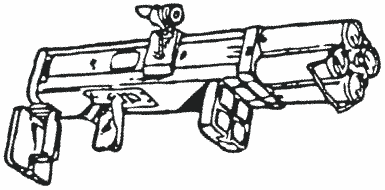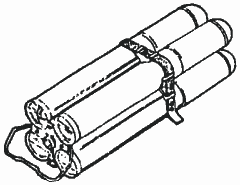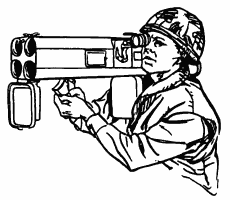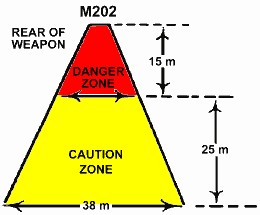| TECHNICAL DATA |
|---|
| Complete System |
|---|
| Country of Origin | USA |
|---|
| Weight with full clip | 26.6 lb (12.07 kg) |
|---|
| Launcher |
|---|
| Length (Closed) | 27 in (686 mm) |
|---|
| Length (Clip Extended) | 34.75 in (883 mm) |
|---|
| Weight Unloaded | 11.5 lb (5.22 kg) |
|---|
| Sight | Reflex |
|---|
| M74 Rocket Clip |
|---|
| Caliber | 2.6 in (66 mm) |
|---|
| Length | 21.5 in (546 mm) |
|---|
| Weight | 15.1 lb (6.85 kg) |
|---|
| Rocket Warhead | M235 Incendiary (TPA) |
|---|
| Muzzle Velocity | 375 fps (114 mps) |
|---|
| Bursting Radius | 22 yd (20 m) |
|---|
| Arming Radius | 5 to 14 yd (5 to 13 m) |
|---|
| Minimum Safe Range | 22 yd (20 m) |
|---|
| Maximum Range | 820 yd (750 m) |
|---|
Range at which 50% probability of hit can be expected
(firing one rocket clip): |
|---|
| Bunker Aperture | 55 yd (50 m) |
|---|
| Windows | 137 yd (125 m) |
|---|
Uncovered weapons positions
and Stationary vehicles | 219 yd (200 m) |
|---|
| Squad-size troop formations | 547 yd (500 m) |
|---|
DESCRIPTION
The M202A1 multishot rocket launcher (Flash) is a lightweight, reusable, four-tube rocket launcher.
It is half as heavy as the M9A1-7 and M2A1-7 portable flamethrowers, has five times the range against point targets,
and requires less servicing and maintenance.
The Flash can be used in both an offensive and defensive role because it is lightweight, has an extended range, and has a minimal maintenance requirement.
Due to the weapon's accuracy and the trajectory of the rocket, it can get into areas and enclosures which other weapons cannot enter.
It can produce personnel casualties in bunkers, buildings, and covered or open foxholes, as well as damage unarmored vehicles and
destroy combustible supplies, ammunition, and materiel.
The M202A1 produces a psychological effect -- the brilliant splash of the bursting warhead makes it an excellent weapon to suppress
RPG and Sagger missile firing sites and when fired near armored vehicles, will normally make the crew button-up.
The Flash may be employed like other direct fire weapons with the assault element or with a supporting element as a supporting or covering weapon.
The M74 rocket is normally employed by infantry elements in the assault for the same purpose as flamethrowers; however, targets can be
engaged at a greater range and with greater accuracy with this weapon than with the portable flamethrowers.
Thus, the M202A1 gunner is less vulnerable to enemy fire than flamethrower operators.
LAUNCHER
The lightweight, shoulder-fired, four-tube launcher is equipped with front and rear hinged protective covers. A folding sight and
trigger handle assembly provide compact carrying and storage capabilities. An adjustable sling is used to carry the launcher over
the shoulder.
The launcher is loaded with a clip (M74), which contains four 66mm rockets.
It can fire one to four rockets semi-automatically at a rate of one rocket per second and can be reloaded with a new clip.
The basic load for each launcher is three M74 rocket clips.
ROCKET
Ammunition for the M202A1 rocket launcher is issued in rocket clips of fixed ammunition (the rocket motor propelling charge is not
adjustable). The rocket clip consists of four aluminum tubes each preloaded with one 66mm rocket.
Each rocket consists of an M235 warhead, containing approximately 1.34 pounds (0.61 kg) of thickened pyrophoric agent (TPA), an M434
fuze, and an adapter, which adapts an M54 rocket motor to the warhead.
The TPA is triethylaluminum (TEA), a substance similar to white phosphorus, which burns spontaneously when exposed to air at
temperatures between 1400-2200 degrees Fahrenheit.
The M434 fuze is a basedetonating (BD), nondelay-action type. It incorporates a graze functioning element which, upon deceleration due
to impact, causes the fuze to detonate the burster in the warhead.
ORGANIZATION
The M202A1 is issued as needed, generally one per rifle platoon.
There is no dedicated gunner for the M202A1, and selected individuals in each rifle platoon and scout platoon should be trained in its use.
FIRING POSITIONS
The M202A1 is aimed and fired from the right shoulder using either the standing, the kneeling, or the prone positions.
The most stable position from which to fire the Flash is the standing supported position.
When firing from a foxhole, there are two limitations.
First, overhead cover can limit the elevation of the rocket launcher and therefore the range.
Second, when elevating the launcher, the gunner must insure that the rear of the launcher is outside the hole so that he is clear of the back blast.
BACK BLAST
The M202A1 has a back blast that must be considered before firing:
Propellant gases escaping to the rear of the launcher can cause severe injury to personnel and damage to equipment located close to the firing position.
The total back blast area extends 130 feet (40 m) to the rear with a base of 125 feet (38 m).
- The danger zone extends 50 feet (15 m) to the rear with a base of 15 meters. All personnel, equipment, and flammable materials must be kept clear of this area.
- The caution zone extends an additional 82 feet (25 m) with a base of 125 feet (38 m). Personnel in this area could be injured from secondary missiles thrown to the rear by the blast.
In a tactical situation, it is unlikely that the back blast area will be completely clear. Consequently, the launcher may be fired
without injury to the firer as long as any rear vertical obstructions are at least 16 feet (5 m) away from the launcher. Friendly
troops providing security must be protected in a fighting position, behind a solid object, or lying prone with steel helmets facing
the firing position.
WEAPON CAPABILITIES
The M202A1 is an extremely effective weapon for combat in cities or built up areas. Flames can be delivered on distant targets
through windows, doorways, or other holes in the structures with pinpoint accuracy. The detonation of rockets within a structure
will create panic and confusion among the enemy occupying the structure.
The M202A1 can deliver area fire out to 547 yards (500 m).
During urban combat, the range to targets is normally much less.
Point targets, such as an alleyway or bunker, can usually be hit from 219 yards (200 m).
Precision fire against a bunker aperture is possible at 55 yards (50 m).
The M202A1 Flash is not effective in penetrating typical urban targets.
It can penetrate up to 1 inch (25 mm) of plywood at 219 yards (200 m), and at close range it can penetrate some wooden doors.
The rocket reliably penetrates window glass.
The M202A1 is not effective against brick or cinder block construction.
The flame agent splattered against the top, flanks, and rear of light armored vehicles can be effective.
The psychological effect of hits by flame rockets on closed-in crewmen is significant.
A round detonating near or on a vehicle's rear deck or engine compartment could set the vehicle on fire.
A wheeled vehicle could have its tires severely damaged by the M202A1.
The minimum safe combat range is 22 yards (20 m), which is the bursting radius of the rocket warhead due to splash back.
If the projectile strikes a hard object along its flight path and breaks open, it will burst into flames even if the fuse has not armed.
M202A1 rocket packs must be protected from small-arms fire and shell fragments that could ignite them.
Variants
- M202 (NSN 1055-00-143-6966)
- Original production model.
- M202A1 (NSN 1065-00-021-3909)
More M202A1 Art - Click on image sample to see full size image.
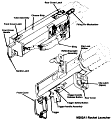
M202A1 Rocket Launcher.
800x860, 49K, GIF
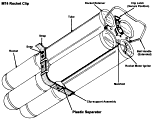
M74 Rocket Clip.
855x675, 39K, GIF
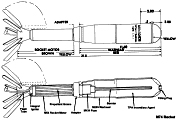
M74 Rocket.
1,020x690, 41K, GIF
